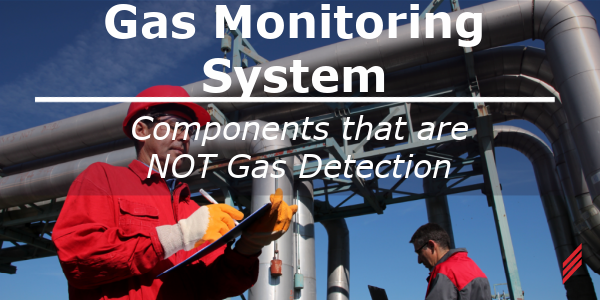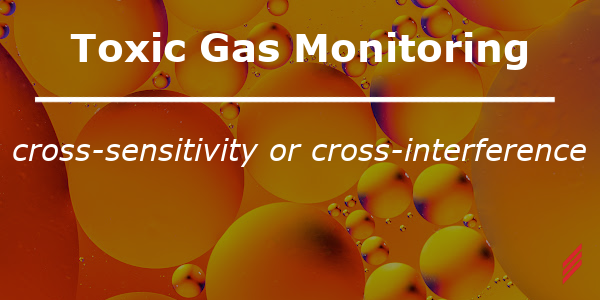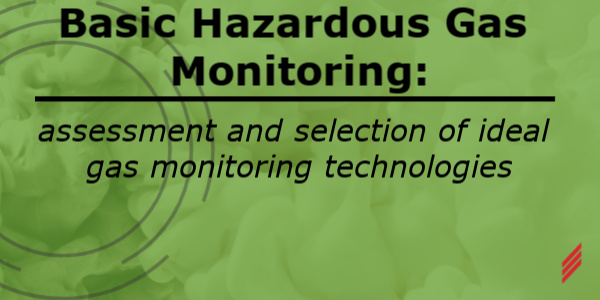Gas Monitoring System - Components that are NOT Gas Detection
by John Kurowski on Aug 18, 2020 10:30:00 AM

Have you ever thought about gas monitoring? It is easy to say yes. Have you ever thought about a gas monitoring system (GMS)? Again, it is easy to say yes. Have you ever thought about all the components required to build a fully functioning GMS? It is not easy to say yes. Further, what is required by code, what do you need, and what do you want in a gas detection system? Let’s explore many of the options commonly found in a gas monitoring system.
After you have contemplated the words gas monitoring, you probably first thought about the gas detection devices themselves. If all the options for gas detection itself is not enough, what about annunciation when the gas detector detects a gas leak? So, now you have gas detection, and strobes and horns. If you are already going down this path, then you probably have one or more gas sources that need to shut off in the event of a gas detection alarm. It would be normal to shut off the gas source if you have a leak. Now you have gas detection, strobes and horns, and some sort of gas shut down command to the gas source(s).
If you have gas cabinets (GCs) and valve manifold boxes (VMBs) that have the capability for gas shutdowns, would you want to know if either the GCs or VMBs have an internal alarm (such as excess flow)? Would you want the GC and VMB alarms to be displayed as part of your gas monitoring system? Now, you have gas detection, strobes and horns, GC and VMB shutdowns, and GC and VMB status communication.
What if there is an active fire with resulting Fire Alarm? Almost universally, the fire department would want the gas sources to be shut down if they are entering a burning building. If you are in the semiconductor industry you are also required to have a 24 hour a day, manned station monitoring gas detection. If your facility is big enough, you may already have a 24 hour a day, manned Building Maintenance System (BMS) office for HVAC alarms. If you are monitoring for HVAC alarms, would you add air flow switches (AFSs) to gas using tools to ensure exhaust flow? Would you want the BMS to notify the GMS if there was a major exhaust fan failure? Would you want to notify the Fire Alarm System (FAS) if you have an ambient gas release? Now, you have gas detection, strobes and horns, GC and VMB shutdowns, GC and VMB status, incoming and outgoing FAS communication, incoming and outgoing BMS communication and AFSs.
Have you ever thought about Emergency Gas Off (EGOs) pull stations or buttons like a Fire Alarm pull station or button? If yes, you now have gas detection, strobes and horns, GC and VMB shutdowns, GC and VMB status, FAS alarms, BMS alarms, AFSs, and EGOs.
Think for a moment how you want to display GMS information. If you have a single small laboratory, maybe you want a compact HMI display by the door into the lab. If you have a large building with gases on multiple floors, maybe you want multiple displays on multiple floors. Would you want touch screen capability? Would you want details for each gas detection point within a facility on one screen or multiple screens? If you have a large number of people that need to get alarm information at home, maybe you want remote access capability. If you want remote access capability, you should probably have software security to limit access to your system. As you add more complex display and access, you then need to start thinking about servers and Virtual Machine (VM) servers. Now, you have gas detection, strobes and horns, GC and VMB shutdowns, GC and VMB status, FAS alarms, BMS alarms, AFSs, EGOs, and servers with software.
Let’s talk about power. Your FAS has emergency power. It is a life safety system. Should your GMS have emergency power? It is also a life safety system. If so, what type of emergency power do you have? Will you need an Uninterruptable Power Supply (UPS) to transition you through the time between normal power and emergency power? Now, you have gas detection, strobes and horns, GC and VMB shutdowns, GC and VMB status, FAS alarms, BMS alarms, AFSs, EGOs, VM servers, UPS, and emergency power.
Maybe your gas using tools have internal gas cylinders. Do you want to shut down tools to trigger the emergency shut off valve for the gas cylinder inside the tool? Do you have gas generating equipment such as hydrogen generators? Equipment like this might feed an entire building. Do you want a flammable gas monitor in your building to signal a H2 generator shut down? If so, your TGMS needs to send signals to tools or equipment shut down in the event of a gas alarm. Now, you have gas detection, strobes and horns, GC and VMB shutdowns, GC and VMB status, FAS alarms, BMS alarms, AFSs, EGOs, VM servers, UPS, emergency power, tool shutdowns, and equipment shutdowns.
This is getting monotonous, but you get the point. The more you think about your new gas detection system, the more features you may want to add. All the above examples come from actual client Gas Monitoring Systems that Hallam-ICS has designed, built, and installed. We have lists, templates, and spreadsheets with all the above features and more. We can bring these solutions to you in an easy to read format called a Safety Requirements Specification. Let us bring you 25+ years of Gas Monitoring System design knowledge, so that you don’t have to worry about all the details to own and operate a fully functional and safe Gas Monitoring System.About the Author
John has a B.S. in Chemical Engineering from Penn State and a M.S. in Manufacturing Engineering from RPI. Prior to coming to Hallam-ICS, John had 30 years of experience working in Manufacturing/Process/Facilities Engineering for printed circuit board and semiconductor manufacturing. As a Senior Engineer at Hallam-ICS, John is responsible for the design and specification of Toxic Gas Monitoring Systems. He participates in all project design phases from concept through construction documents.
Read My Hallam Story
About Hallam-ICS
Hallam-ICS is an engineering and automation company that designs MEP systems for facilities and plants, engineers control and automation solutions, and ensures safety and regulatory compliance through arc flash studies, commissioning, and validation. Our offices are located in Massachusetts, Connecticut, New York, Vermont and North Carolina and our projects take us world-wide.
You May Also Like
These Related Stories
Why Toxic Gas Monitoring Is Critical for Labs and Manufacturing Facilities

Toxic Gas Monitoring: Cross-Sensitivity or Cross-Interference



No Comments Yet
Let us know what you think